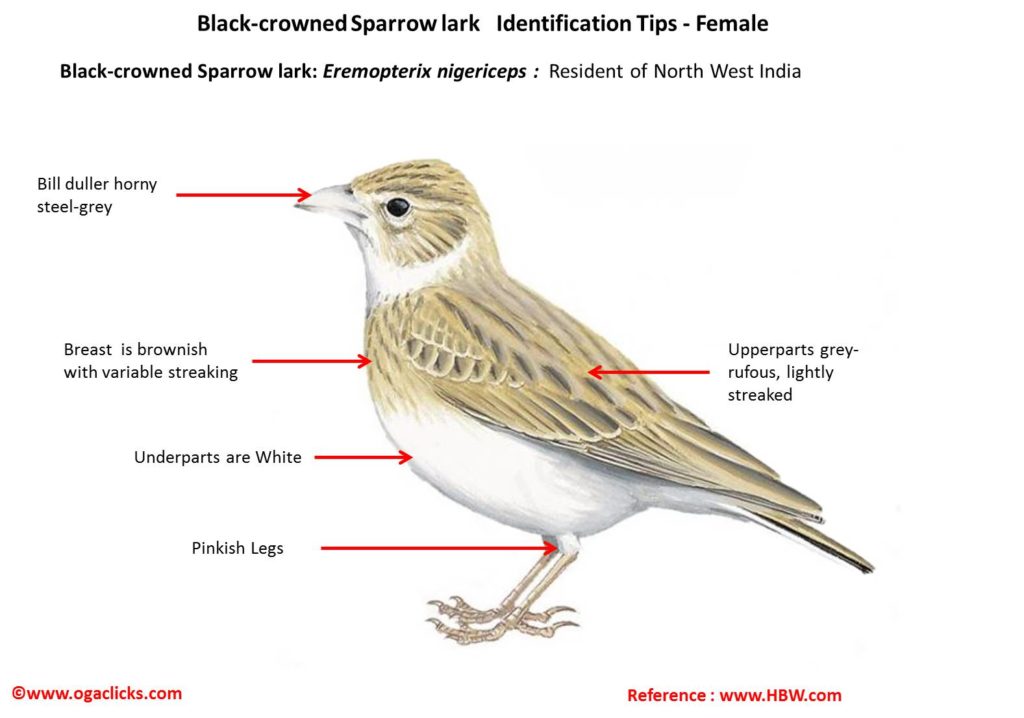

Black-crowned Sparrow Lark Eremopterix nigriceps
Etymology :
- Eremopterix : Greek word eremos- desert ; pterux – wings
- Nigrcieps : Latin word niger- black; ceps –headed { Black headed}
Distribution in India: Resident of North-West India.
Description:Size of 12-13 cm. The adult male of nominate race has distinctive black-and-white head pattern; upperparts are sandy-brown with reddish tinge, paler and greyer in worn plumage ; wings are dark brown, wing-coverts with pale fringes, median coverts form darker bar on folded wing; tail dark brown, central feather pair with broad pale greyish margins, outer rectrices with narrower whitish edges; chin and entire underparts are black, except for white thighs and narrow white stripe down side of breast; underwing-coverts and undertail black, underside of flight-feathers sooty grey-brown; eyes dark brown; bill bluish-white; legs pale flesh. The female lacks male’s distinctive head pattern, is rather nondescript at rest, greyish-rufous above, whitish below, brownish with variable streaking on breast, dark underwing with black underwing-coverts and bill is duller horny steel-grey.
Habitat:It is found in arid and semi-arid plains with scattered grass and other low-lying vegetation; prefers sandy soils rather than rocky substrates. Also occurs around saline pans.
Food Habits: It eats seeds and small invertebrates like bugs, termites and beetles. It feeds on the ground, stance rather erect compared with that of congeners; takes items from ground surface or from plants, also gleans items from cattle dung; occasionally flutters up to grasp prey out of reach, and also hawk for insects with great agility in air. Most foraging takes place in early morning and evening
Breeding Habits: They breed in Feb-Sept in India. The male performs aerial display over territory, rises steeply from ground , circles while calling for up to 1 minute, then descends in a series of shallow swoops; members of established pair also frequently display together, male chasing female in rapid, twisting low flight; also variety of displays by male to female on ground, including rushing at female with crest raised, head angled down and wings drooped (“charging”), strutting with raised head, vertical tail and drooped wings (“tail-cocking”), approaching female in near-prostrate creeping posture (“sidling”), and apparently less intense form of last with crest raised (“horizontal rigid”). The Female selects nest-site, also builds nest, in 2–3 days. The nest is a shallow depression excavated with the breast, by turning around with wings spread, or natural hollow used where substrate hard, lined with large twigs, then with finer grass stems, leaves and awns, also wool, paper and other litter, rim usually decorated with small stones or clods of earth. The nest site typically at base of a grass tuft or shrub, normally on N or E side and thus shaded from hot afternoon sun. The male, and occasionally female, defend nest-site against other bird species and lizards. They lay a clutch of 2–3 eggs. The egg laying starts 2–3 days after nest completed, with laying interval of 1 day. The incubation starts from second egg, by both sexes, female doing more work . The incubation period is 11–12 days, last chick hatches 20–35 hours after other two and is much smaller. The chicks are brooded and fed by both parents, female doing greater part of brooding, male provisioning more, brooding most intense in hot weather, involves standing over chicks to shade them; feeding mostly in early morning and evening .The faecal sacs removed by both parents or, rarely, swallowed at nest. The male, occasionally also female, distracts intruders by feigning injury or scuttling away from nest. The chicks start to leave nest for short periods from day 6, typically leave entirely by day 8, long before able to fly. Within a day after leaving the nest, each parent takes sole responsibility for one chick, and chicks separate, possibly to reduce risk of predation. The young can run strongly by day 12, flutter weakly by day 14, although wings develop by day 21–22, when tail is still barely developed.
Other habits : In hot weather seeks shade under bushes, or occasionally in large lizard burrows during heat of day, greatly reducing water loss; loses heat by flying with legs dangling, or by perching with drooped wings, facing into wind, on elevated site. It requires little water, but drinks regularly when water available; tolerates brackish water, drinks water even along seashore and from tidal lagoons.